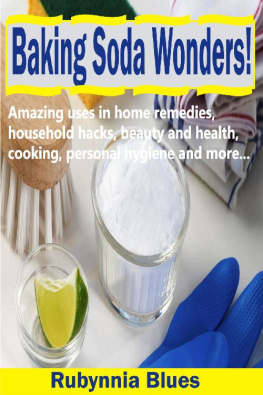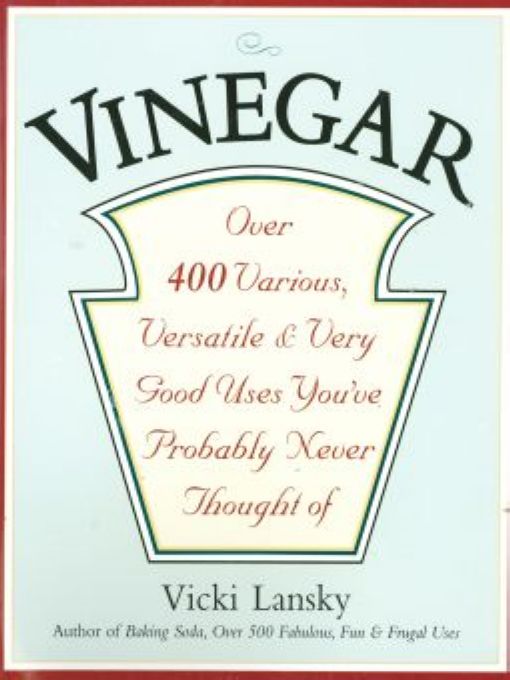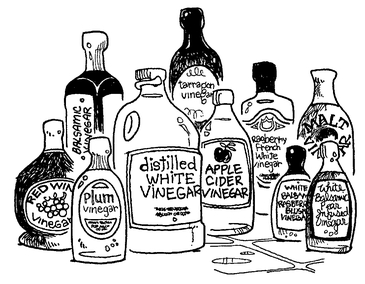Table of Contents
Dear Reader,
I became interested in great ways to use vinegar because of what I learned when writing about and talking aboutfor the last 5 yearsmy book, BAKING SODA Over 500 Fabulous, Fun and Frugal Uses You Probably Never Thought of. And I learned a lot.
It would be fair to say that I now use a LOT of baking soda and a LOT of vinegar around my house. I love their economy and I love their multipurpose qualities.
This is far from a complete discussion of everything there is to know about vinegar. If you want to know more there are additional books that can give you: a more detailed history, more recipes, more about various vinegars and more in-depth technical details.
I love vinegar for what it can do for me on a daily basis and that is what I have shared with you here.
Vicki Lansky
...a word to the wise
I cant tell you how every idea here works. Nor have they all been used by me. But each has worked for someone, which is how I learned of it, and it just might be useful to you. Conditions and situations are unique to each of us. Keep in mind that home remedies can not take the place of competent medical advice. I can not guarantee each and every tip. Use common sense and use this book to increase your repertoire of great uses for vinegar andI believeyoull enhance your home, health and happiness.
VINEGAR
A BIT OF BACKGROUND
Vinegar has been used in many different ways by many different peoples for thousands of years. In ancient Rome, bowls of vinegars made from wine, dates, figs and other fruits were used for the dunking of breads. Rice vinegar has a long history in China, going back 3000 years. Japanese samurai believed a rice vinegar drink would boost their strength. Vinegar is mentioned in early Middle Eastern writings for medicinal uses ranging from a clotting agent to a digestive aid to an expectorant. It was used in dressing wounds and was valued as both a medicine as well as a condiment.
Cleopatra demonstrated its solvent property by dissolving precious pearls in vinegar to win a wager that she could consume a fortune in a single meal. Vinegar is mentioned as often in the Bible as is wine. In the New Testament, it is said that a sponge soaked in vinegar was held to the lips of Jesus to ease his thirst while on the Cross.
Doctors tending those who were contagious during the Black Plague rubbed vinegar, infused with essential oils and herbs, over their own bodies. They also used it inside their hooded cloaks as an inhalant for their own protection. A variation of this practice was common in the eighteenth century when vinegar-dipped sponges were held to the nose to offset odors of raw sewage and the lack of indoor plumbing.
George Washington in his final illness was given a gargle concoction of vinegar and sage. During the American Civil War vinegar was used on wounds as a healing agent. Soldiers also drank it in an attempt to ward off scurvya vitamin C deficiency. (Im assuming it was cider vinegar.)
Vinegar has been a mainstay of many folk recipes that have been handed down for generations. Today modem industry uses vinegar in dozens of waysfrom reducing microorganisms in slaughter houses and poultry plants to cleaning equipment in the construction industry.
Vinegar (which literally means sour wine) results when wine or another alcoholic liquid is allowed to ferment a second time, turning it acetic. If you let wine be exposed to the bacteria in the air, it will ferment and eventually turn into vinegar.
The word vinegar comes from the French word vinaigre (vin for wine and aigre for sour). It is actually bacteria spores that convert a fermented liquid into vinegar. It then becomes a weak form of acetic acid. It is formed through this second fermentation of sugars or starches. Vinegar can come from the juice of sweet fruits and grains such as barley (malt beer), apple (cider) and grape (wine), yet it can also be made from roots or wood (often the base of white distilled vinegar). Filipinos use coconuts as their vinegar base; Mexicans use the cactus fruit that is the base for tequila.
One hundred grams of basic distilled white vinegar has 16 calories. It contains small amounts of protein and starch. It has no vitamins but does contain trace amounts of various minerals. Vinegars made from other bases will contain some of the nutrients of the plant or fruit from which it was derived.
VINEGAR IN THE KITCHEN
Vinegar has been a kitchen staple for many generations. It is a trusted health remedy, a neutralizer, a cleaner, a condiment and a preservative. Its acetic quality enables it to kill bacteria, mold and germs while being safe enough not to harm the body or the environment. According to the Heinz Company (maker of one of the most popular consumer brand name vinegars), numerous studies show that their straight 5 percent acetic solution of distilled white vinegar, found in supermarkets, kills 99 percent of bacteria, 82 percent of mold and 80 percent of germs. Sometimes you may see the acid measured in grains. 50 grains is the same as a 5 percent acid level, and is the most common percentage. Since distilled white vinegar is not registered as a pesticide the label cannot claim it as a disinfectant. Vinegar is available in higher acetic concentrations, but this is not easy to find in consumer outlets as it can be more hazardous and needs to be handled with appropriate precautions.
A FOOD FAVORITE
Vinegar is safe and edible, and it cannot harm your stomach when ingested in small amounts. When it comes to food enhancements and vinaigrettes, multiple types and flavors of vinegars are available. The world of culinary vinegars is a large one. Many types of vinegar are flavored by the addition of herbs or fruits; raspberry vinegar is one of the most popular. For the diet conscious, vinegar is fat free and low in sodium.
Use simple white distilled vinegar when a sharp acidity is needed without any other characteristics. The distilling process destroys its nutrients, making it a purer and more tart acetic acid as well as clear in color. Many vinegars in stores today also have preservatives added.
Vinegars made from other bases have different flavors. Common types of culinary vinegar include balsamic (often used for oil and vinegar salad dressings), red wine, white wine, rice wine, sherry, champagne, Chinese red and, of course, cider vinegar. Malt vinegars and brown rice vinegars are most often used with fish and chips. Distilled vinegar used in making pickles works best with at least a 5 percent or higher acidity level. Read your labels when making your choices.
Do not confuse rice wine with rice wine vinegar. Read the label carefully. If it says wine vinegar, then it is vinegar, not wine. Asian grocery stores usually carry three basic types of rice vinegarwhite, red and black. Rice vinegars tend to be milder as rice (the base) has a lighter taste. Rice vinegar is a byproduct of sake or Japanese rice wine. The popular seasoned rice vinegars have a blend of sweeteners and salt added giving it a light taste. It has become a healthy alternative for many, as a salad dressing and a flavor enhancer.










